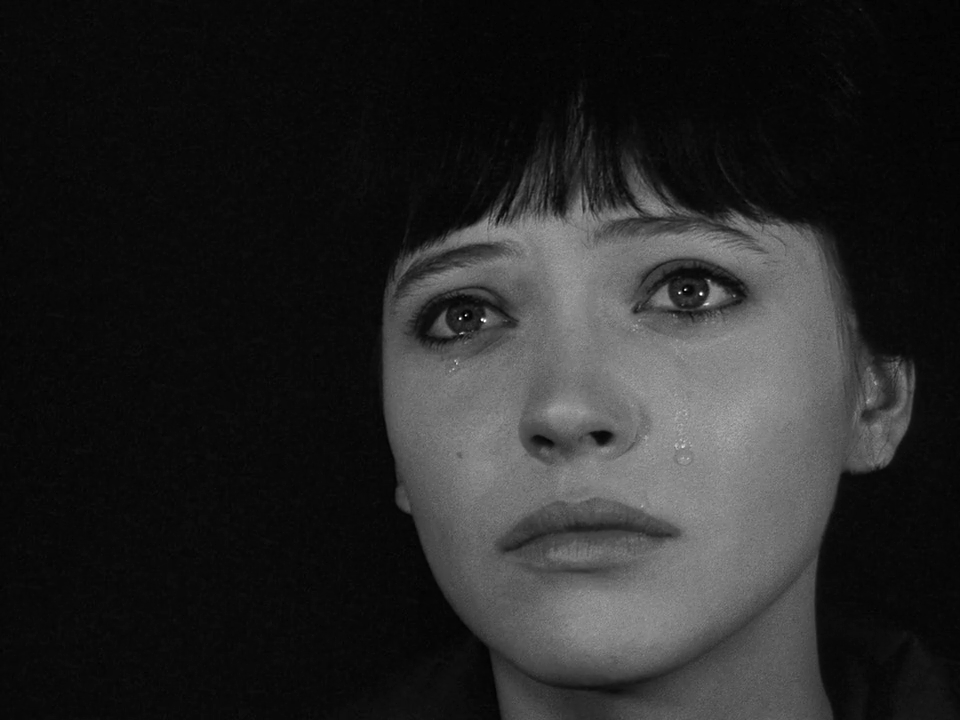
A film about Nana, a young Parisian who aspires to be an actress but instead ends up a prostitute.
EN
“Godard takes his moto for this film – essay on freedom and responsibility from Montaigne: ‘Lend yourself to others; give yourself to yourself.’ The life of the prostitute is, of course, the most radical metaphor for the act of lending oneself to others. But if we ask, how has Godard shown us Nana keeping herself for herself, the answer is: he has not shown it. He has, rather, expounded on it. We don’t know Nana’s motives except at a distance, by inference. The film eschews all psychology; there is no probing of states of feeling, of inner anguish.”
Susan Sontag1
“Vivre sa vie was a profound experience for many of us. I was amazed by scene after – the record store, where the camera moves with Anna Karina’s character Nana according to the demands and the rhythm of her work; the encounter with the philosopher Brice Parain in the café; the ‘documentary’ sequence where the details of Nana’s trade as a prostitute are laid out before us with clinical detail on the soundtrack and visual poetry on the screen. But it was the full effect of the film was so illuminating. Nana was seen from so many different perspectives and studied so carefully and closely that it was like seeing a great portrait painted by a master right before our eyes. For some, her sudden, brutal death was unsatisfactory. For me, it felt right, because that was the way it happened out on the streets.”
Martin Scorsese2
- 1Susan Sontag, “On Godard’s Vivre sa vie“, Moviegoer, no. 2, Summer/Autumn 1964, p.9.
- 2Martin Scorsese, “Godard is Perhaps Dead”, Cahiers du Cinéma, 13 October 2022.
NL
“Bij Godard bestaat dit niet, deze interpretatieve combinatie van beeld en taal die beweert het innerlijk van de personages te vatten en een volmaakt beeld ervan te geven. Er wordt duidelijk gemaakt dat de taal niet enkel dient om het beeld te begeleiden. Ze wordt integendeel als een onafhankelijk, gelijkwaardig expressief element naast het beeld geplaatst. In plaats van het geruststellende samenspel van beeld en taal om de overzichtelijkheid te vergroten van wat wordt weergegeven, worden in Vivre sa vie zowel het afgebeelde als de manier van afbeelden via een constante splitsing van beeld en taal gerelativeerd. Bovendien resulteert deze scheiding in een dubbel perspectief: het perspectief van de afgebeelde personages en het perspectief van degene die hen ziet. Godards camera bewaart een afstand; hij registreert. Godard weigert de kijker via dramaturgische manipulaties een mening op te dringen. De werkelijkheidsaanspraak van zijn kunst berust niet op een zo trouw mogelijke nabootsing van de werkelijkheid, maar manifesteert zich in de erkenning van het fictieve karakter ervan.”
Frieda Grafe1
- 1Frieda Grafe, “Vivre sa vie (Het verhaal van Nana S.) van Jean-Luc Godard,” vertaling door Sis Matthé), Sabzian, 29 januari 2020.

